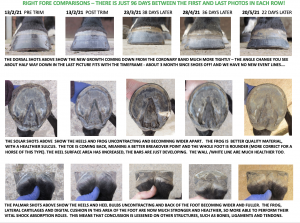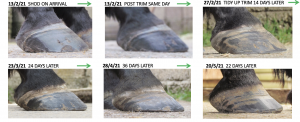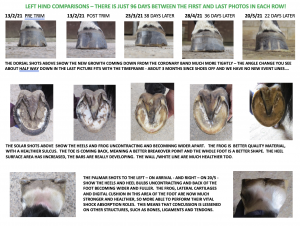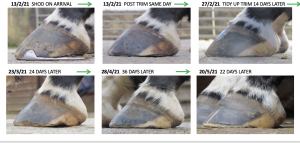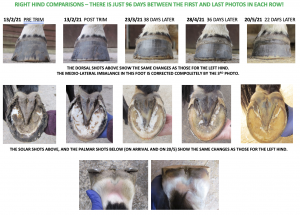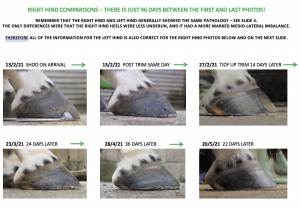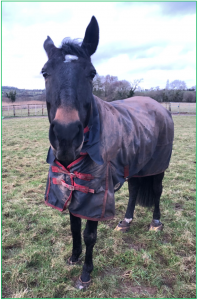
Loki in the paddock
‘Loki’ a 7 yo sports horse arrived at my yard for rehabilitation in February ’21, primarily with a two year history of variable level intermittent lameness in front. His right fore was lower and flatter than his left fore. Previously he also had intermittent hind limb lameness, and found it hard to stretch over his topline.
He was in extremely light work on straight lines in walk with a tiny amount of trot as his soundness allowed, had previously had huge amounts of box rest or very limited turnout, and all conventional routes had been exhausted, but he ‘never quite came right’.
TIMELINE PRE EP intervention
Loki was rehabilitated at the Equine Podiatrist’s yard.
Over his 3 month stay he had only time to grow ‘half a hoof capsule’. The full effect of these changes will be seen when the new hoof reaches the ground, and the old hoof has grown out, with still more improvements likely over a longer period of time
On arrival he was landing incorrectly toe first on all four feet, when he left to return home, his hind feet were landing correctly when barefoot and his front feet were landing correctly when barefoot on a soft surface, or in boots and pads on a hard surface.
He was also sound on a circle in walk and trot on the lunge, and was ready to start light ridden work again
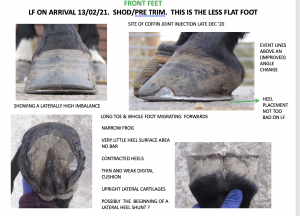
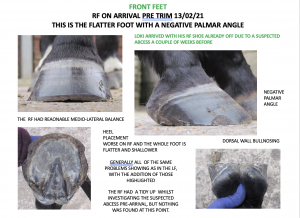
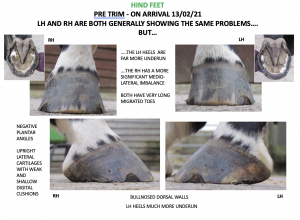
The rehabilitation protocol was to
•Take shoes off, and fitt boots and pads on all four feet for protection and comfort when necessary – vital to keep horses comfortable when transitioning to barefoot
•Trim the feet to encourage correct function and balance – because he was on site he could be trimmed ‘little and often’ meaning everything stayed optimal, helping to speed up the improvements
•The boots and pads also provided appropriate stimulation, and so returned correct function to all of the structures in his feet, meaning they were finally able to recover the previous degeneration and gain strength
•He was turned out 24/7 using a mixture of surfaced track and large grazing areas – essential for his mind as well as his body and feet
•As he became more reliably sound in his boots and pads, he was hand walked around the lanes to increase the stimulation and therefore the strength in his feet
•He was seen regularly by a chartered physiotherapist, and put on a rehab program of stretches and exercises to help his body – within 5 weeks he had lost all of the compensatory muscular issues he had been suffering from
•He was fed a balanced, sensible, barefoot friendly diet with free access to hay and appropriate grazing and gut support products to help his gut recover from what he’d experienced before.
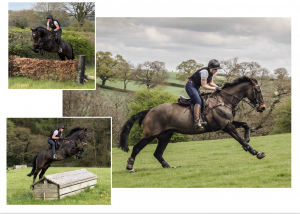
The sequence of lateral shots below show the new growth coming down from the coronary band at a much better angle , with no new event lines. By the time of the last photo this has reached half way, fitting with the 3 month timeframe since the shoes came off – you can also see this on the dorsal shots on the next page. The whole foot has stopped migrating forwards, and is coming back underneath the limb. The breakover at the toe is fairly close to optimal by the final photo and once the new growth reaches the ground this should be truly correct. Although the heels were never terribly underun on this foot, if you look at the hairline it has stopped ‘curling under’ at the heels and become straighter, meaning the digital cushion and lateral cartilages here are fuller and stronger – you can see this nicely on the palmar shots on the next page. This has corrected the collapsed internal arch. All of this has created a much better hoof pastern axis – you can see this by comparing the pastern /dorsal hoof wall angles to the ground – there is approximately 10 degrees difference in the first and last photos! This means less strain on joints, tendons, ligaments and muscles further up the limb too.
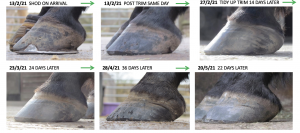
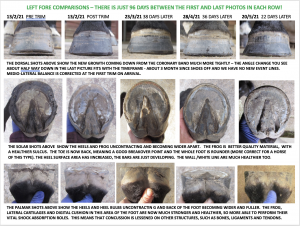
The right fore showed worse pathology than the left fore – negative palmar angles had been confirmed on x-ray, the heels were underunning, and the dorsal wall bullnosing, indicating an incorrect toe first landing.
The sequence of lateral shots below show the new growth coming down at a very different and much better angle – look at the huge difference most noticeable in the last photo. You can also see this on the dorsal shots on the next page. The new dorsal wall is growing straight rather than bullnosing, meaning the landing is now correct heel first. The whole foot has stopped migrating forwards, and is coming back underneath the limb . the breakover at the toe is slowly improving and once the new growth reaches the ground this should be truly correct. The heels were fairly underun – look at the first and last photo and compare the angle of the wall at the heels, and the point where this meets the ground –very almost corrected – just a little more time needed. The hairline has almost stopped ‘curling under’ at the heels and become straighter, as the digital cushion and lateral cartilages have become fuller and stronger, so correcting the collapsed internal arch. This is all creating a much better hoof pastern axis – you can see this by comparing the pastern and new dorsal wall angles to the ground – like the lf there is approximately 10 degrees difference in the first and last photos!
